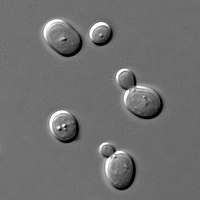
Photo from wikipedia
Xylose is the second most abundant sugar in lignocellulosic biomass and on the planet. In the second-generation bioethanol production process, it is essential to metabolize all sugars obtained in the… Click to show full abstract
Xylose is the second most abundant sugar in lignocellulosic biomass and on the planet. In the second-generation bioethanol production process, it is essential to metabolize all sugars obtained in the hydrolysis of lignocellulose to increase ethanol titers and conversion yields of biomass to biofuel and decrease production costs. Wild-type Saccharomyces cerevisiae strains, the workhorse microorganisms in ethanol production, are not able to ferment xylose. In this review, a comparison in bioethanol production from xylose was carried out between non-conventional yeasts and recombinant strains of Saccharomyces, highlighting the advantages and disadvantages according to the most important factors that influence sugar metabolism to ethanol, such as the assimilation pathway used, co-assimilation with glucose, oxygen levels, tolerance to fermentation inhibitors, and process temperature, among others. The review begins reviewing the metabolic pathways of xylose assimilation, followed by the associated cofactor imbalance, heterologous expression of xylose isomerase (XI), regulation of xylose reductase (XR) and xylitol dehydrogenase (XDH), and the relevance of genes involved in the pentose phosphate pathway (PPP). Likewise, the importance of other yeasts, such as Scheffersomyces stipitis, Candida shehatae, and Kluyveromyces marxianus, as non-conventional yeasts to produce bioethanol is highlighted, due to their ability to ferment a wide range of sugars, including xylose, compared to S. cerevisiae.
Journal Title: BioEnergy Research
Year Published: 2021
Link to full text (if available)
Share on Social Media: Sign Up to like & get
recommendations!